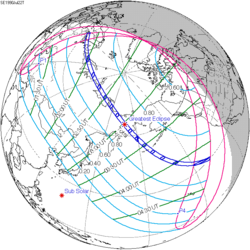| Total eclipse | |
| Gamma | −0.5725 |
|---|---|
| Magnitude | 1.029 |
| Maximum eclipse | |
| Duration | 174 s (2 min 54 s) |
| Coordinates | 13°06′S148°18′E / 13.1°S 148.3°E |
| Max. width of band | 119 km (74 mi) |
| Times (UTC) | |
| Greatest eclipse | 2:46:05 |
| References | |
| Saros | 129 (55 of 80) |
| Catalog # (SE5000) | 9681 |
A total solar eclipse will occur at the Moon's ascending node of orbit on Saturday, May 22, 2077, [1] with a magnitude of 1.029. A solar eclipse occurs when the Moon passes between Earth and the Sun, thereby totally or partly obscuring the image of the Sun for a viewer on Earth. A total solar eclipse occurs when the Moon's apparent diameter is larger than the Sun's, blocking all direct sunlight, turning day into darkness. Totality occurs in a narrow path across Earth's surface, with the partial solar eclipse visible over a surrounding region thousands of kilometres wide. Occurring about 3.2 days after perigee (on May 18, 2077, at 20:50 UTC), the Moon's apparent diameter will be larger. [2]
Contents
- Eclipse details
- Eclipse season
- Related eclipses
- Eclipses in 2077
- Metonic
- Tzolkinex
- Half-Saros
- Tritos
- Solar Saros 129
- Inex
- Triad
- Solar eclipses of 2076–2079
- Saros 129
- Metonic series
- Tritos series
- Inex series
- Notes
- References
The path of totality will be visible from parts of Australia, Papua New Guinea, and the Solomon Islands. A partial solar eclipse will also be visible for parts of Australia, Indonesia, Antarctica, and Oceania.

































































































